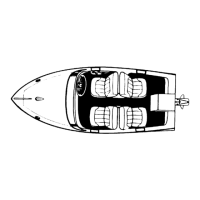ELECTRONIC FUEL INJECTION (MULTI-PORT AND THROTTLE BODY) - 5E-1590-823225--1 1096
KNOCK SENSOR
The knock sensor is mounted on the lower right side
of the engine block.
73051
When abnormal engine vibrations (spark knock) are
present, the sensor produces a voltage signal which
is sent to the KS Module and then to the ECM. The
ECM uses this signal to aid in calculating ignition tim-
ing.
KNOCK SENSOR (KS) MODULE
The KS module contains solid state circuitry which
monitors the knock sensor’s AC voltage signal and
then supplies an 8-10 volt signal, if no spark knock is
present, to the ECM. If spark knock is present, the KS
module will remove the 8-10 volt signal to the ECM.
b
c
d
e
a
Knock Sensor System
a - Electronic Control Module (ECM)
b - 12 Volts Battery Positive
c - 8-12 Volts
d - Knock Sensor
e - Knock Sensor Module
It is extremely important that the correct KS sensor
and module be used for the engine application. Using
an incorrect KS module will result in unrecognized
spark knock and engine damage. The KS module ter-
minal B is powered by 12 volts from the ignition
switch thru system relay. If the 12 volt power source
is not present, the KS module cannot send an 8-10
volt signal to the ECM and a false constant spark re-
tard will result. A code 43 will be set.
Terminal E of the KS module is the signal line from the
knock sensor. If this circuit opens or shorts to ground,
the KS module will never remove the 8-10 volt signal
from terminal C to the ECM and no spark retard will
occur. The ground circuit for the KS module is con-
nected to terminal D. If the ground circuit opens, the
KS module will not be able to remove the 8-10 volt
signal to the ECM and spark knock cannot be con-
trolled.
On certain models (1996 And older engines only),
the ECM will do a self test when the following condi-
tions are reached:
• Engine temperature above 150° F (66° C).
• Engine RPM above 4000 RPM.
• 5.024 Hg in. (80 kPa) manifold pressure
THROTTLE POSITION (TP) SENSOR
The Throttle Position (TP) Sensor is a potentiometer
connected to the throttle shaft on the throttle body.
The TP has one end connected to 5 volts from the
ECM and the other to ECM ground. A third wire is
connected to the ECM to measure the voltage from
the TP. As the throttle valve angle is changed, the
voltage output of the TP also changes. At a closed
throttle position, the voltage output of the TP is low
(approximately .5 volt). As the throttle valve opens,
the output increases so that at wide-open-throttle
(W.O.T.), the output voltage should be near 4.5 volts.
By monitoring the output voltage from the TP, the
ECM can determine fuel delivery based on throttle
valve angle (driver demand). A broken or loose TP
can cause intermittent bursts of fuel from the injector
and an unstable idle, because the ECM thinks the
throttle is moving.
73049

